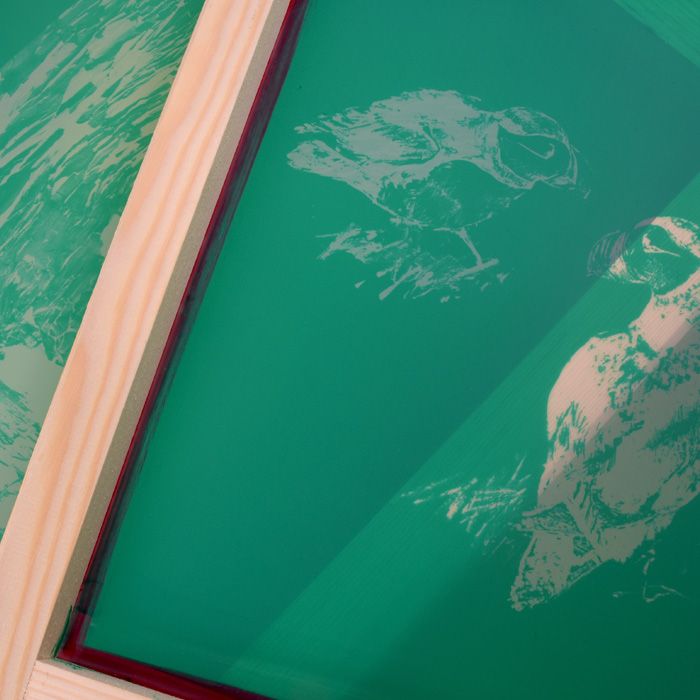Affordable Custom Screen Printing Services for Small Businesses
Affordable Custom Screen Printing Services for Small Businesses
Blog Article
Screen Printing Uncovered: Whatever You Need to Understand About T-Shirt and Garment Printing Strategies
If you have actually ever before asked yourself just how those vibrant designs finish up on your favorite t-shirts, you're in the appropriate area. Screen printing is an interesting approach that incorporates art with strategy, using countless opportunities for creative thinking. Understanding the fundamentals, from devices to ink choices, can substantially impact your outcomes. Ready to check out the crucial components that make screen publishing an art kind? Let's discover the information that can elevate your projects.
The Fundamentals of Display Printing: How It Works
When you plunge right into screen printing, you'll uncover it's both an art and a science. At its core, screen printing entails developing a pattern, or screen, that permits ink to go through just in details locations (screen printing kit). You start by choosing your layout and preparing your display with a light-sensitive emulsion. Once you reveal this emulsion to light, it sets, leaving your layout as a negative room.
Following, you'll mix your inks and prepare your printing surface area. Position the display over the textile, after that make use of a squeegee to push ink via the screen onto the garment. This procedure calls for precision, as you desire clear, vivid prints. After printing, you'll heal the ink with warmth, guaranteeing it abides by the fabric and lasts via laundries. Each action is necessary, and understanding them will raise your display printing abilities, transforming simple garments into one-of-a-kind, expressive pieces.
Sorts Of Display Printing Methods
Once you understand the essentials of display printing, it's time to check out the numerous strategies that can boost your styles. One prominent technique is typical display printing, where ink is pressed with a stenciled screen.
An additional choice is plastisol printing, understood for its toughness and dazzling colors, making it a favored for lots of brands. Experiment with halftone printing to develop gradient effects and intricate layouts.
Crucial Equipment for Screen Printing
To achieve stunning outcomes in display printing, having the appropriate equipment is essential. You'll require a durable display printing structure, which holds the mesh that transfers your style onto the garment. Next, spend in high-quality squeegees; these are necessary for applying ink equally across the screen.
Selecting the Right Inks and Materials
When selecting inks and materials for screen printing, you require to consider the kind of ink that works best for your project. Believe concerning fabric compatibility to assure your styles look last and excellent lengthy. Explore environmentally friendly ink alternatives to make your printing procedure more sustainable.
Sorts Of Screen Inks
Picking the appropriate display ink is necessary for achieving lively, resilient prints that fulfill your job's needs. There are several kinds of screen inks to take a look at. Plastisol ink is preferred for its convenience and convenience of usage, supplying exceptional shade opacity on dark fabrics. Water-based ink, on the other hand, provides a softer feeling and is green, making it perfect for those looking to lessen their ecological impact. Release inks eliminate dye from the textile, leading to a soft, vintage appearance yet require details handling. Lastly, specialty inks, such as glow-in-the-dark or metallic, can include unique impacts to your designs. Examine your task demands and choose the ink that aligns ideal with your preferred outcome.

Textile Compatibility Considerations
Recognizing fabric compatibility is vital for achieving high-grade display prints, particularly considering that various products react distinctly to numerous inks. When choosing inks, consider the material type-- cotton, polyester, or blends. For cotton, water-based inks work well, providing gentleness and breathability. Polyester, on the various other hand, typically needs plastisol inks for far better adhesion and dynamic shades. You might need to use a combination of both types if you're printing on blends. Always test your inks on sample material to guarantee they stick correctly and preserve shade integrity. Additionally, keep in mind that textile weight and structure can affect the last result, so selecting the ideal ink and product combination is essential for your job's success.
Eco-Friendly Ink Options
Green inks are coming to be a popular selection for display printers who want to decrease their environmental influence while maintaining high quality. When choosing inks, take into consideration water-based inks, which are much less damaging and easier to tidy up compared to traditional solvents. These inks bond well with materials, providing dynamic results without hazardous chemicals. You might also check out eco-solvent inks that use fewer volatile natural compounds (VOCs), making them a more secure alternative for both your health and the world.
Additionally, look for inks made from sustainable resources, such as soy or vegetable-based options. By selecting the best inks and materials, you'll not only produce stunning designs but additionally add to an extra sustainable printing procedure. Make the switch, and your prints will certainly show your commitment to the setting!
Preparing Your Layout for Display Printing

File Format Needs
To guarantee your layout looks have a peek here dynamic and sharp on textile, you'll require to pay attention to submit format needs for display printing. Start with vector documents like AI or EPS, as they can be scaled without shedding quality. If you use raster pictures, choose high-resolution documents, such as TIFF or PNG, preferably at 300 DPI. Avoid making use of JPEGs, as they can shed quality when resized. Also, make certain your layout has a clear history to prevent undesirable white sides on your prints. Lastly, keep color modes in mind; CMYK is basic for screen printing, so convert your RGB designs appropriately. By adhering to these standards, you'll set your art work up for a successful print.
Shade Splitting Up Techniques
Color splitting up is an essential action in preparing your design for screen printing, and mastering it can considerably enhance your print high quality. You'll require to break your design into specific colors, as each shade requires a separate display throughout printing. This accuracy not just guarantees precise color depiction however additionally enhances the printing process.
Resolution and Size
Attaining the finest results in display printing starts with assuring your layout has the ideal resolution and size. Ideally, your art work must go to least 300 DPI (dots per inch) for sharp, clear prints. Your last product may look unprofessional and pixelated. if you utilize lower resolution.
When it involves dimension, take into consideration the dimensions of your print area. Design your artwork to match the last print size, ideally creating it in the actual measurements you'll be publishing. In this manner, you'll avoid any kind of unexpected scaling problems.
Constantly examine your design in both vector and raster styles. Vector graphics can be scaled without losing high quality, making them optimal for screen printing. Preparing properly will assure your design looks impressive on every garment!
Step-by-Step Display Printing Process
Screen printing is a dynamic procedure that allows you to produce vivid designs on numerous surfaces. To get begun, you'll require a screen, solution, and your selected ink.
After cleaning out the unexposed emulsion, your screen is all set. Establish it up on your printing surface area and straighten your garment under it. Pour ink onto the screen and make use of a squeegee to press the ink through the pattern onto the textile. Raise the display very carefully and let the print completely dry. Cure the ink using warmth to guarantee toughness. That's it! You've effectively display printed your layout.
Tips for Successful Display Printing Projects
While you're diving right into your screen printing jobs, bear in mind that prep work is vital to success. Beginning by collecting all your materials-- inks, squeegees, garments, and displays. A tidy office aids avoid unwanted errors, so clean up before you begin.
Next, validate your artwork is high-resolution and properly sized for your garment. Test your display for proper exposure and tidy it completely to stay clear of smudges. When blending your inks, follow the maker's standards to attain the appropriate uniformity.
During printing, use even stress Web Site with your squeegee for constant results. Don't hurry; take your time to confirm each print satisfies your standards. After printing, allow your garments completely dry entirely before handling or packaging them.
Lastly, constantly maintain an example of your help future referral. By doing this, you can examine your progress and improve your methods over time. Pleased printing!

Often Asked Inquiries
For how long Does It Take to Establish up a Display Printing Job?
Establishing a display printing job normally takes around 30 mins to an hour. You'll prepare the screens, mix inks, and readjust journalism. The time varies based on intricacy and experience, so stay arranged!
Can I Publish on Different Fabric Types Making Use Of the Very Same Technique?
Yes, you can print on various material types utilizing the same method, but you'll need to adjust your settings and inks. Some fabrics absorb ink in different ways, so experimenting assurances the very best outcomes for every material.
What Are Common Mistakes to Stay Clear Of in Screen Printing?
When screen printing, stay clear of usual errors like making use of the wrong ink, disregarding proper direct exposure times, or skipping pre-press checks. Always test your configuration and maintain tidy find more information screens to assure quality results each time.
Just How Can I Appropriately Tidy and Preserve My Screen Printing Devices?
To appropriately tidy and preserve your screen printing tools, you should frequently clean displays with ideal solvents, check squeegees for wear, and ensure all devices are stored dust-free and completely dry. Consistency improves and avoids pricey repair work performance.
Is Screen Printing Eco Friendly Contrasted to Other Approaches?
Display printing can be more eco-friendly than other methods, specifically if you make use of water-based inks and eco-conscious products. By picking sustainable products and practices, you minimize waste and lessen your influence on the earth.
Display Printing Uncovered: Whatever You Required to Know Concerning T-Shirt and Garment Printing Methods
At its core, display printing includes producing a pattern, or screen, that permits ink to pass via just in details areas. Position the display over the textile, then make use of a squeegee to push ink through the screen onto the garment. One prominent technique is typical display printing, where ink is pressed with a stenciled display.When selecting inks and products for screen printing, you require to take into account the kind of ink that works ideal for your job.
Report this page